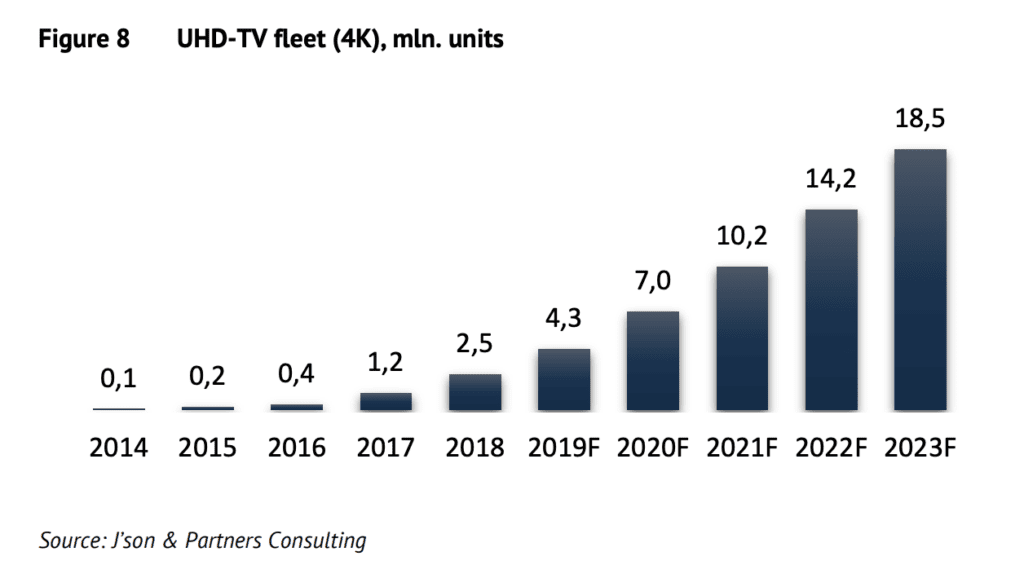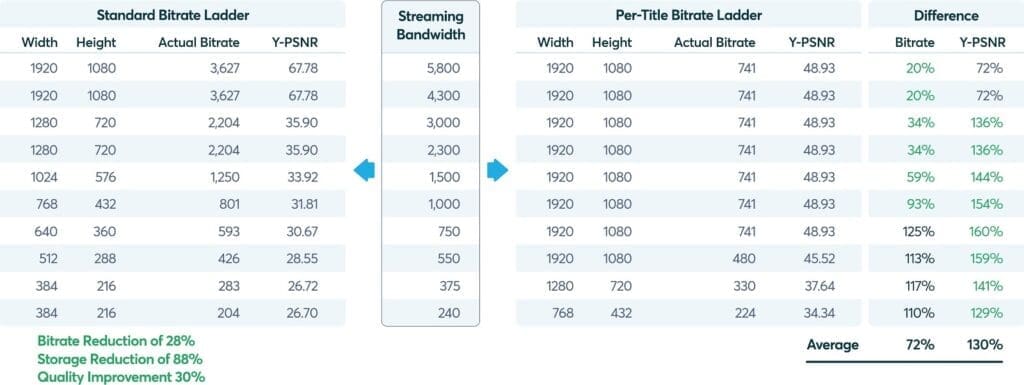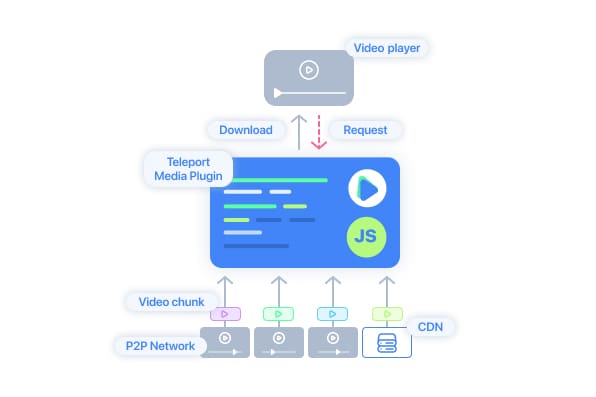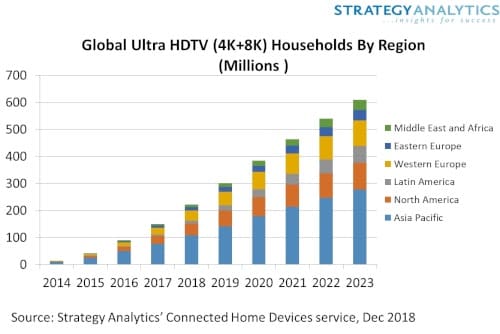
Starting in the late 2010s, consumers, OTT providers, and device manufacturers have come to expect 4K resolution content as the norm, with 4K UHD TV unit sales surpassing 108 million purchases as of 2019 (it’s estimated 178 million units were sold in 2020). According to Omdia, nearly every region in the world (with the exception of APAC & MEA) has a 50% or higher market ownership of UHD-supported TVs. Although a huge percentage of the population owns a 4K supported device, and most modern content is captured in 4K – very few distributors can actually deliver the content in its best quality.

In addition, countless content owners have an enormous backlog of non-4K quality content that simply doesn’t seem right on a high-quality device. According to a recent study & webinar by Streaming Media, roughly 45% of content distributors utilize 4K UHD to bring premium content to market. With that in mind, it’s imperative that OTT providers find ways to deliver as much of their content in HD quality and higher. In today’s times of online streaming revolution that’s defined by hyper-dynamic Video Tech development, it’s possible to deliver older content into UHD quality content using 4K upscaling technologies (such as per-title encoding, upsampling, and super-resolution).
In this article (featuring Teleport Media, a decentralized delivery services provider), we’re going to talk about 4K video as the new QoE standard and how some of our respective clients are achieving 4K quality distribution with the help of next-gen video optimization solutions without breaking the bank.
Status Quo: 4K Quality for Streaming Media
According to multiple industry reports, the current market penetration of 4K devices (or higher) such as Smart TVs, tablets, and mobile phones is valued at roughly $62B and is expected to grow to $213B by 2026. In addition, the market for 8K devices is expected to balloon 72 million sold devices (globally) by 2025, from a measly 350,000 in 2020.
According to a report by the European Audiovisual Observatory, Russia has rapidly become one of the largest growing consumer markets for 4K content (and devices) with HD channel (and OTT service) subscriptions reaching as high as 28 million households, with the expectation that 18.5 million of those households will own a UHD capable device by the year 2023.

A key example of content operators expanding their libraries to support and upscale 4K content is Bitmovin and Teleport Media’s joint customer, Okko multimedia service – one of the largest Russian VOD services, with a monthly viewership of 17 million households. To achieve the market’s demand for 4K content, Okko had to implement a back-end strategy that would equally leverage new incoming 4K content and upsample their existing library with a scalable and affordable video workflow.
How Okko is Upscaling Content to 4K
As the OTT streaming market continues to rapidly grow across Russia, Okko has taken aggressive action to improve the viewer experience of its users. Working with Bitmovin to implement the latest Dolby Vision experience as well as reworking existing content for an optimized 4K and HD viewing experience by implementing an adaptive bitrate ladder encoding methodology.
The adaptive bitrate ladder streaming methodology analyzes the elements of a video based on the type of content that’s being displayed to optimize intra-frame and inter-frame compression. The process compensates and optimizes motion, spatial and temporal compression for quality control all while minimizing bitrates. This enables organizations like Okko to deliver 4K by implementing the least lossy and most compressive encodes and automatically adapting video segments based on the available bandwidth of various regions. You can find a chart of the standard bitrate ladder below as compared to the ladder for Bitmovin’s per-title encoding solution:

By applying per-title encoding, Okko has been able to continuously provide UHD content for all of their native apps and web services, increasing the availability of premium content for customers across all of Russia. According to Okko CEO, Yana Bardintseva:
“We believe that new features and coding algorithms will help us to strengthen Okko’s position as a technological leader among VOD services and provide our clients with the best possible 4K visual quality on the market.”
Bitrate Upscaling Methods
As you can imagine, just because a majority of modern stream-capable devices can deliver all of their content in 4K, doesn’t mean that they will. The limitations around delivering 4K content come from all angles – such as media files that aren’t natively in UHD resolution, bandwidth limitations due to poor connectivity, and even server & distribution capabilities from “outdated” infrastructures (4G and below networks). So, how can distributors overcome these limitations? With a mix of bitrate upscaling methods, such as per-title encoding, decentralized content delivery mechanisms, and future technologies like super-resolution.
Per-Title Encoding
The entire concept of bitrate upscaling is about the process of introducing higher bitrates without adding any hardware or making significant changes to video workflow. One way to do so is with the aforementioned per-title encoding method, wherein content is compressed efficiently and effectively enough to be delivered at (potentially) 4K quality resolution, regardless of bandwidth availability. This can be enabled by setting up a wider bitrate ladder that encompasses 4K content.
Decentralized Content Delivery
Another method of introducing higher bitrate capacity into a video workflow is by applying a decentralized CDN. This is a cloud-based service that manages the peer-to-peer network created out of the devices watching the same video, where each new viewer acts as an “edge mini-server” and video redistributive node. The peer-to-peer architecture positively affects the highest possible visual quality maintenance both from the tech side and the business side.
The P2P architecture enables a higher delivery speed by splitting up encoded video chunks between multiple viewers in parallel, thereby lightening the buffer requirements on any given network. Given that 4K content takes up significantly more space than any other media file, spreading out the video chunks between reliable peers reduces the server load.
Additionally, a decentralized CDN plugin to a video player acts like an intuitive load balancer that optimizes the cost of delivery by enabling networks to deliver 2-3x more traffic at the same price. Thus, content distributors can now deliver 4K quality at the cost of HD.

As up to 80% of traffic can pass through a P2P network, the server is no longer forced to downgrade the video and won’t get overloaded from the 4K content pulls. As a result, more viewers can consume the higher resolution content concurrently. The viewers got improved visual quality at the last mile despite OTT’s data centers capacity and available bandwidth.
Super-resolution
With delivery infrastructures and bandwidth limitations removed with the combination of cloud-based encoding and P2P CDNs, organizations can look towards innovative technologies to start upsampling their older content. A relatively new methodology to upsampling older content is the practice of super-resolution (with machine-learning), where non-4K content is improved using a mathematical calculation to predict what an image will and should look like based on previous frames (otherwise known as Spatial Upsampling). Super-resolution is better than other forms of upsampling, as it adapts its predictions based on the content that’s been input (similar to per-title encoding).
Now if you combine all three methods of bitrate upscaling, you’ll be guaranteed to provide one of the best 4K video experiences available on the market.
Meet the market: Best QoE with Bitrate Upscaling
Bitmovin’s encoding and Teleport Media’s P2P CDN solutions both are designed to create the highest QoE with their focus on bitrate upscaling. The application of an adaptive bitrate streaming solution that’s delivered concurrently across countless peers will help any organization upgrade its lower-quality content and cope with the fierce market competition. In addition, content distributors will be able to reach the ever-growing market of 4K and 8K capable devices.

As UHD reach is expected to spread over 600 million households worldwide, it’s imperative that you deliver content that matches the quality of the device, be it with spatial upsampled content through super-resolution, with extended ABR ladder using Bitmovin’s Per-Title or 3Pass Encoding, and/or with Teleport Media’s decentralized P2P CDN solution.
If you’d like to learn more about per-title encoding, super-resolution, ABR ladders, P2P CDNs, and other video infrastructure technologies, check some of our additional resources below:
[Blog Series] Super-Resolution with Machine Learning:
- https://bitmovin.com/super-resolution-machine-learning-p1/
- https://bitmovin.com/super-resolution-machine-learning-p2/
- https://bitmovin.com/super-resolution-deployments-machine-learning-p3
[Blog Post] Video Compression Basics: Encoding Definition and Adaptive Bitrate
[Use Case] How to transform the quantity into quality and decrease buffering 50%
[Case Study] Globo is Setting 4K Standards with Per-Title Encoding
Contact Bitmovin
Contact Teleport Media


